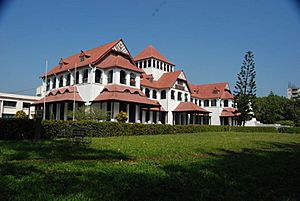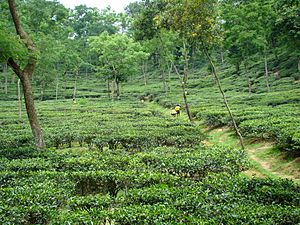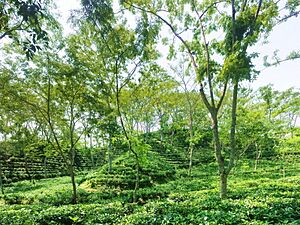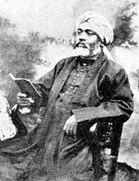Tea production in Bangladesh facts for kids
Bangladesh is an important country for growing tea. It's actually the 10th largest tea producer in the world! The story of tea in Bangladesh goes way back to when the British ruled the area. The East India Company first started growing tea in the hills of the Sylhet region. Tea farming also began in Greater Chittagong around 1840. Today, Bangladesh has 166 tea farms, called estates, some of which are among the biggest in the world. The tea industry makes up 3% of all the tea produced globally and provides jobs for more than 4 million people.
Tea grows best in the northern and eastern parts of Bangladesh. The high lands, mild weather, humidity, and lots of rain in these areas create perfect conditions for growing high-quality tea.
History of Tea in Bangladesh

Long ago, the area of Bengal was the end point of the "Tea Horse Road." This was a trade route that connected the subcontinent to early tea-growing places in China. People believe that Atisa, a famous person from Bengal, was one of the first to drink tea there.
Growing black tea started in Bengal and Assam when the British Empire was in charge, especially in the Sylhet district of Assam. In 1834, a man named Robert Bruce found tea plants in the Khasi and Jaintia Hills and other hilly areas in the northeast. This discovery led to the creation of the Assam Tea Company in 1839. Many business people, like Haji Mohammed Hashim and Dwarkanath Tagore, were involved with this company.
The first tea gardens in the area were set up by European traders in the port city of Chittagong in 1840. They planted Chinese tea plants from the Calcutta Botanical Garden near the Chittagong Club. The very first tea grown and made in Bangladesh was tasted near the Karnaphuli River in Chittagong in 1843.
Commercial tea growing, meaning growing tea to sell, officially began at the Mulnicherra Estate in Sylhet in 1857. The Surma River Valley in the Sylhet region became the main area for tea growing in Eastern Bengal. Tea farms also grew well in Lower Tippera (which is now Comilla) and Panchagarh in North Bengal. Panchagarh is now the third important tea-growing area in Bangladesh, and some of the most popular teas come from there.
Tea was a very important product that British Bengal exported. The Assam Bengal Railway was super important for the tea industry. It carried tea from the farms in the Surma and Brahmaputra Valleys to the Port of Chittagong, where it was shipped out.
In the early 1900s, many local business people also started their own tea companies. Some of these pioneers included Syed Abdul Majid, Nawab Ali Amjad Khan, and Muhammad Bakht Majumdar.
The Chittagong Tea Auction was started in 1949 by British and Australian traders. For a long time, British companies like James Finlay and Duncan Brothers were the biggest players in the tea industry. The Ispahani family also became very important in the tea business.
Tea Industry Today

Tea is the second biggest cash crop that Bangladesh exports, right after jute. The tea industry makes up 1% of the country's total economic output (GDP). The main districts where tea is grown include Moulvibazar, Habiganj, Sylhet, Chittagong, Panchagarh, Brahmanbaria, and Rangamati.
Bangladesh used to export a lot of tea, but now it actually buys more tea from other countries than it sells. This is because more and more people in Bangladesh are buying tea, especially as the middle class grows. So, the industry is now focused more on selling tea within the country. Today, big Bangladeshi companies run most of the tea business. These include M. M. Ispahani Limited, Kazi & Kazi, the Transcom Group, and others like the Orion Group.
In 2012, Bangladesh produced the most tea it ever had, making 63.85 million kilograms. The country has over 56,846 hectares of land used for growing tea, which is a lot more than the 28,734 hectares it had in 1947. The government is also encouraging smaller tea growers, especially in the Chittagong Hill Tracts.
The price of tea from Bangladesh is decided at a public sale, called an auction, in Chittagong. In March 2015, the international price for Bangladesh tea was about US$2.40 per kilogram.
Right now, the Moulvibazar District has the most tea farms in all of Bangladesh.
Tea Garden Workers
More than 300,000 people work in the tea gardens of Bangladesh. About 75% of these workers are women. Many of them are descendants of tribal workers who were brought from central India by the British a long time ago. These workers are among the lowest paid in the country, earning about 120 taka (around $1.25 US dollar) per day.



